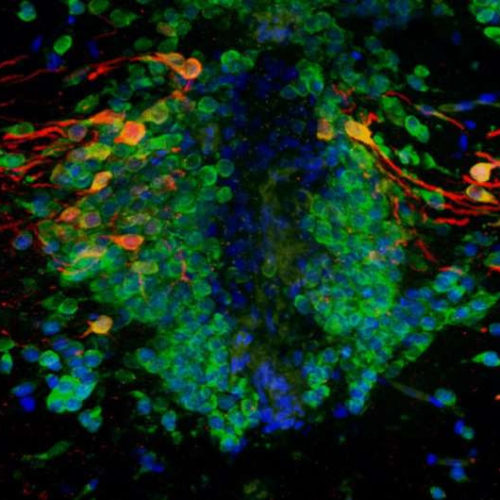IOS PRESS IMAGE: A) SCHEMATIC REPRESENTATION OF IMPORTANT CONNECTOME DETAILS IN PARKINSON’S DISEASE (PD). B) BRAIN-FIRST PD: THE ASYMMETRIC DISTRIBUTION OF ALPHA-SYNUCLEIN PERSISTS INTO LATER DISEASE STAGES. C) BODY-FIRST PD: THE SYMMETRIC ALPHA-SYNUCLEIN PATHOLOGY LEADS TO MORE SYMMETRIC MOTOR SYMPTOMS. CREDIT: JOURNAL OF PARKINSON’S DISEASE. Amsterdam, April 28, 2021 – Parkinson’s disease (PD) is characterized...
Category: <span>parkinsons</span>
Interaction of mitochondria and lysosomes key in Parkinson’s disease
by Will Doss, Northwestern University A tiled image of a single neuron showing the scale of a neuron compared to HeLa cells. The cell body of a dopaminergic neuron is smaller than regular somatic cells, but its neurites are very long in their length, which is one reason why different organelle dynamics were observed in sub-compartments...
Study identifies two neuronal populations associated with symptoms of Parkinson’s disease
by Ingrid Fadelli , Medical Xpress Credit: Lilascharoen et al. Parkinson’s disease is a progressive neurodegenerative disorder that manifests itself through a diverse range of motor and non-motor symptoms, including shaking and stiffness of the limbs, as well as difficulties in maintaining balance and coordination, walking and talking. As the disease progresses, these symptoms typically...
Study shows why crossing obstacles is difficult for patients with Parkinson’s disease
by FAPESP The scientists detected incapacities related to gait timing and foot placement. Their discoveries serve as a basis for the development of an exercise protocol that mitigates the difficulty. Credit: Movi-Lab A multidisciplinary research group affiliated with the Department of Physical Education’s Human Movement Laboratory (Movi-Lab) at São Paulo State University (UNESP) in Bauru, Brazil, measured step...
Rates of Parkinson’s disease are exploding. A common chemical may be to blame
Researchers believe a factor is a chemical used in dry cleaning and household products such as shoe polishes and carpet cleaners ‘The EPA estimates that 250 million pounds of TCE are used annually in the US.’ Photograph: Justin Kase/Alamy Stock PhotoWed 7 Apr 2021 09.04 EDT Asked about the future of Parkinson’s disease in the US,...
Brain cells decide on their own when to release pleasure hormone
by NYU Langone Health Credit: Pixabay/CC0 Public Domain In addition to smoothing out wrinkles, researchers have found that the drug Botox can reveal the inner workings of the brain. A new study used it to show that feedback from individual nerve cells controls the release of dopamine, a chemical messenger involved in motivation, memory, and movement. Such “self-regulation,”...
Distinct Parkinson’s disease symptoms tied to different brain pathways
by University of California – San Diego A three-dimensional rendering of a mouse hemisphere shows brain-wide projection patterns of GPe neurons labeled by mRuby2 (soma, axonal fibers) and eGFP (pre-synaptic sites). Credit: Lim Lab, UC San Diego Parkinson’s disease (PD) is well known as a debilitating disease that gradually worsens over time. Although the disease’s progression...
Parkinson’s gene may impair how new neurons are made throughout our lifetime
by University of Sheffield Old (green) and newly made (orange) dopamine-producing nerve cells in the zebrafish brain. Credit: University of Sheffield A pioneering study, published in Scientific Reports, found that the Parkinon’s gene PINK1 is important for the generation of dopamine-producing neurons throughout life, and is not just responsible for the premature death of these neuronsThe international research,...
Convincing evidence that type 2 diabetes is associated with increased risk of Parkinson’s
QUEEN MARY UNIVERSITY OF LONDON Research from Queen Mary University of London has concluded that there is convincing evidence that type 2 diabetes is associated with an increased risk of Parkinson’s disease. The same study found that there was also evidence that type 2 diabetes may contribute to faster disease progression in patients who already have...
Immune cells in blood influence the brain during early development of Parkinson’s disease
AARHUS UNIVERSITY Parkinson’s disease has always been considered a brain disorder. However, new research reveals a close link between the disease and certain immune cells in the blood. Researchers from Aarhus University have taken the first step on a path which can lead to new ways of understanding and, in the long term, possibly treating this widespread disease...








